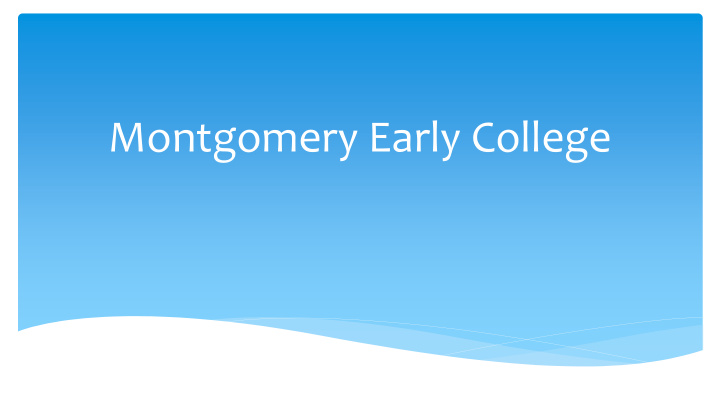



Montgomery Early College
The Early College Defined Original Intent: Focus on young people for whom the transition into postsecondary education is problematic. Targets students who are; At risk of dropping out of high school, First-generation college students, and/or Students who would benefit from accelerated learning opportunities. (CIHS@dpi.nc.gov) (Jobs for the Future - EC History) High school located on campus of community college or university. Typically grades 9 – 13 Complete high school requirements and two years of college within five years. No charge to the family.
Brief History of Early College Program Idea for early college started in 2002. Came out of a conversation educational leaders within the state. Small group of retired superintendents (What if we could change the high school experience for students in the state) NC New Schools (Bill and Melinda Gates Foundation) Jobs for the Future Leadership Group for the Carolinas Developed school change coaches Developed a common instructional framework Worked with school systems for a planning year and first year of operation to develop new innovative high schools.
History (Continued) Today – General Assembly Oversees Funding Creating a new school Legislation The Innovative Education Initiatives Act (SL 2003-277, Senate Bill 656) Cooperative Innovative High School Programs statute (§ 115C-238.50-.55) Currently, NC has over 100 Cooperative Innovative High Schools, including 80 funded partnerships. LEAs interested in creating a Cooperative Innovative High School must apply in partnership with an Institution of Higher Education.
Benefits to MCC Attracting current and future students Students who would not have attended otherwise Students who complete part of a degree More likely to stay in the college and community Students see educational opportunities in Montgomery County Train for local careers Expands funding for MCC Increased enrollment Utilizes excess course capacity
Benefits to MCS Expands opportunities for students Students earn college credit while still in high school At risk students don’t get lost in the system Allows MCS to market to wider audience of students Allows MCS to provide more rigorous curriculum to combat “charter school” issue
Benefits to Montgomery County Aligns to business needs for a more technically skilled and educated workforce Professional and technical curriculum focused on these much sought after and needed skills for ALL enrolled students Allows for expansion of internships and work-based/field-learning opportunities – Train from within instead of looking without … Allows for specific training on industry standard equipment Education with a future career focus leads to fewer dropouts – easing the burden on social services and criminal justice system
Advantages to Students who Attend an Early College Seamless transition Course credit counts for both high school and college credit Eliminates course duplication High school and college programs are integrated Free college education Smaller more personal environment Most courses will enroll 10 – 20 students Higher graduation rate 90% vs 78% nationally Own school culture Students can personalize their environment
Design Plans Working on architectural plan Aligned to discussion of USDA funding
Coursework
Criteria for Participation in an Early College First generation college students or based upon student need Declared major Reflects the make-up of the school district Enrollment must focus on high school mission i.e. STEM oriented early college Technical abilities (Past performance in math and science) Lottery system will be developed to handle an anticipated influx of applications each year
Tentative Timeline April 2016 Submit letter of intent May – August Application development September Submit application September – March Approval process Summer Final approval Fall 2017 Early College opening
Other Questions Would one high school change the Early College Concept? Would not negatively affect Early College Would strengthen it Early college would be an independent high school Early college would be a collaborative entity between MCC and MCS, with shared spaces and equipment…only strengthening the current partnership and helping both organizations while ultimately benefitting the future of Montgomery County So, what are the benefits of centralization and consolidation?
Benefits of a Central High School More diverse offerings to include a wider array of CCP Courses – More students in CCP = more offerings No program duplication means there will be more ample funding to maintain the highest quality of industry standard equipment Increased access to clubs, student organizations, and competitions Increased access to internships, apprenticeships, job-shadowing, and cooperative learning opportunities Wider variety of courses for OCS students
Benefits of Central HS – Cont.’ Better coordination for student services and guidance Centralized Band, Art, Drama, and Chorus Programs Increased access to historically low enrollment courses that may not make in our traditional program Consolidations would save the County approximately $28,000,000 over the next 30 years - $15m in maintenance costs and $13m in personnel Will strengthen relationship between MCS and MCC A constant, steady stream of possible future students driving by MCC every day
And Finally….Briefly – EMS Wing Addition
EMS Site Plan
Recommend
More recommend